A detailed,realistic rendition of the King’s face and hands emerge from a field of crimson,as his bright red tunic merges with a turbulent red background.
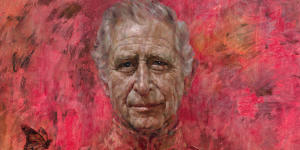
King Charles III by Jonathan Yeo 2024.Getty
All that red has obvious,instant associations,causing the portrait to be constantly described as “bloody” or “fiery”. Is there a subversive message buried in this canvas?
At first glance I thought the palace was on fire,with Charles looking strangely pleased as he was engulfed in flames,perhaps hoping soon to be reborn,as symbolised by the butterfly hovering over his right shoulder. Charles is no Nero,but he knows he may be presiding over the last days of an anachronism.
The challenge for the royal family today is not so much to stay relevant as an institution,as to stay visible. The contemporary world is obsessed with celebrity,and celebrity is a state of extreme visibility in which substance is not a necessary ingredient. Look at Donald Trump. He’s never off our screens,but his only subject is himself.
It was,therefore,a shrewd move to have the newly crowned King Charles III painted by one of Britain’s most fashionable portraitists. Jonathan Yeo has painted everyone from Damien Hirst to Tony Blair,from Nicole Kidman to Dennis Hopper,to a nude and pregnant Sienna Miller. He is a first-choice celebrity portraitist in the manner of Belle Époque artists such as Giovanni Boldini or Jacques-Émile Blanche.
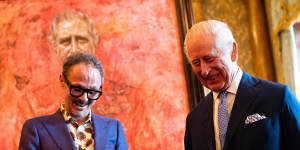
Jonathan Yeo with King Charles at the unveiling of the portrait.Getty
Like these predecessors,he is a creature ofle juste milieu, or the happy medium. The earlier artists incorporated a dash of Impressionist flair into their realistic portrayals of well-known people. Yeo does the same thing with abstract art,creating a realistic facsimile of a sitter’s face and hands,but immersing the figure in a storm of loosely applied brushstrokes. The result is a painting that manages to look daring and modern in the most superficial manner,without sacrificing a recognisable likeness. It’s an each-way bet.
His Majesty King Charles III is not so very different from most of Yeo’s portraits. Even that confronting shade of red has been used on other occasions. One of his least adventurous efforts depicts now-Queen Camilla,in demure shades of grey. It may be considered a deposit on the eventual commission to paint her husband.
That mass of sizzling red disguises the essential mediocrity of the painting,and works a similar trick for Charles,as this colour invariably triggers associations with anger,passion,or desire. Most of the earlier portraits of Charles,made while he was Prince of Wales,take a very different approach.
Consider Bryan Organ’s 1980 portrait in the National Portrait Gallery,London. A 31-year-old Charles sits in a deckchair,with his legs crossed. He wears riding boots,khaki pants,and a blue pullover. His face is turned towards us,looking serious and engaged. A large blue-grey fence isolates Charles within the composition,implying that he is to be viewed as an individual,not a mere figurehead of the monarchy.
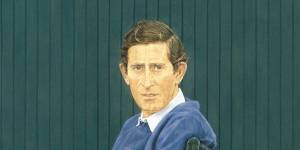
Bryan Organ’s 1981 portrait of Prince Charles.National Portrait Gallery London
Organ’s portrait flatters Charles but in a very subtle way,capturing the mildly rebellious figure who was willing to make critical comments on the excesses of modern architecture. It’s the year before his fateful marriage to Diana,in 1981,a liaison that would eventually damage his public image.
Australian Ralph Heimans painted Charles in 2018,standing by the window in Dumfries House in Scotland. Now he wears a grey suit and an alert expression,and holds a walking stick,as if he is preparing to go outside for a stroll. The artist said he wanted to allude to Charles’s support for the environment and Britain’s architectural heritage,but these themes are not signposted in the picture which remains a conventional piece of realism.
Heimans’s portrait may be staid,but it’s a psychological masterpiece compared to Victoria Crowe’s portrait of the same year,exhibited at the Scottish National Portrait Gallery. In this work a blank-faced Charles sits by a window,seemingly oblivious to the nicely painted trees outside,which vie for our attention.
There are many other portraits of Charles,most of them incredibly dull,constrained by the formality of the monarchy,the respect due to the sitter,or simply the artists’ lack of talent.
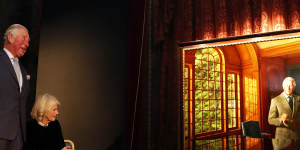
King Charles and Queen Camilla (then the Prince of Wales and Duchess of Cornwall),at the unveiling of a portrait by Ralph Heimans at London’s Australia House in 2018.AP
Yeo and Heimans are probably the two best-known artists to paint King Charles,but with time,the Bryan Organ painting looks the pick of the bunch.
There will be more to come,as there are countless portraits of Queen Elizabeth II,fromCoronation Day (1953),Cecil Beaton’s grand,staged photo of the young Queen in full regalia,to Polly Borland’s startling close-up of 2001,set against a shiny gold backdrop. Another memorable photo is Chris Levine’sLightness of Being (2012),which shows the 86-year-old Elizabeth with her eyes closed.
One needs to draw a line between commissioned works that required sittings,and those unofficial “portraits” drawn from pre-existing images,such as a silkscreen by Andy Warhol or a cartoonish picture by George Condo,let alone the image on the Sex Pistols’ single,God Save the Queen.
Among the commissioned works,Pietro Annigoni’s austere,elegant portrait of 1954 has become iconic. The Queen,just two years into her reign,stands outlined against a chilly looking sky,in a landscape that could have been borrowed from a Flemish Old Master.
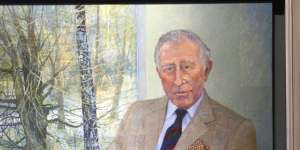
Victoria Crowe’s portrait of the Prince of Wales.Getty
William Dargie’s tonal portrait was painted in the same year as Annigoni’s work,during the Queen’s lengthy visit to Australia. Local colour is provided by Elizabeth’s yellow dress,which has earned the picture the nickname “the wattle painting”. The fresh-faced young Queen strikes quite a contrast with Lucian Freud’s tiny portrait of 2000-2001,in which she looks decidedly grumpy.
Elizabeth wouldn’t have been the first model to feel worn out sitting for Freud,who had asked permission to paint the Queen,requesting numerous sittings over 19 months. When the picture was revealed to the public,the tabloids were scandalised. It’s been unkindly suggested the finished portrait looks more like Freud himself.
These changing images of King Charles and Queen Elizabeth indicate the British monarchy’s desire to keep up with the times while not relinquishing the dignity of an office defined by duty and protocol. It’s a far cry from Pharaonic Egypt,in which the image of a giant-sized king smiting his tiny enemies was repeated for more than 3,000 years. In ancient times the chief objective of a royal portrait was to emphasise the power and prestige of a ruler who ranked second only to God.
The Egyptians and most other ancient civilisations created idealised images of rulers,stressing their perfections.
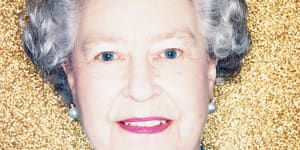
Polly Borland’s 2002 portrait of Queen Elizabeth II.Polly Borland
From the Renaissance onwards,portraitists set out to capture the actual likeness of a king or queen,but there was still an imperative to emphasise power. It can’t have been easy for Velázquez to make an impressive figure out of Philip IV of Spain,but he managed to do so by putting this homely fellow on a huge horse,as we see in theEquestrian Portrait of Philip IV (1635-36) in the Prado.
Goya didn’t even try,in his portrait ofCharles III in a Hunting Dress (1788). Stooped,awkward and ugly,the Bourbon king cuts a pathetic figure,but – more affable than many monarchs – Charles was highly pleased with the picture.
The apogee of flattery arrived with Jacques-Louis David’sNapoleon Crossing the Alps (1801),depicting the diminutive emperor-to-be striking a heroic pose on a rearing horse. In reality,Napoleon had crossed the Great St. Bernard Pass clinging to a donkey. Several years later David would refine his sycophancy with a huge painting of Napoleon’s coronation.
The British monarchs have been well served by their portraitists,even if the greatest of them were foreigners. Hans Holbein the Younger (1497-1543) transformed the massive bulk of Henry VIII into the epitome of power and glory. He captured the wives,the statesmen and Church leaders with such fearsome objectivity we almost feel we know these people personally. Henry,however,complained that Holbein’s portrait of Anne of Cleves had fooled him by being far too flattering. Although she became his fourth wife,as agreed,the king was grievously disappointed with Anne in the flesh. The brief marriage went unconsummated,but Anne kept her head,received a generous settlement,and outlived all the other wives.
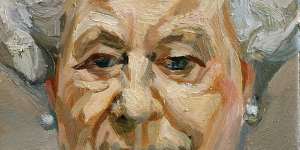
Lucian Freud’s portrait of Britain’s Queen Elizabeth II.AP
Holbein’s only rival as Britain’s greatest royal portrait painter was Anthony Van Dyck (1599-1641),whose work at the court of the ill-fated Charles I,was stupendous. Although he may have the unhappy distinction of being the only British ruler to be executed,Charles was also the greatest royal art collector and connoisseur. He accumulated some 1,500 paintings and 500 sculptures by masters past and present,from Leonardo da Vinci and Raphael to Rembrandt and Rubens.
Van Dyck,who had been Rubens’s student and protegé in Antwerp,made the king look consistently suave and intelligent. Whatever the defects of his actual personality,we look upon Charles with sympathy because of van Dyck’s sensitive portraits. Whether he be on a giant horse,out hunting,or sitting with his family for a formal portrait,Van Dyck imbues the monarch with a unique vitality.
If King Charles III is ever going to rival his unfortunate namesake as a patron of art,he’ll need something better than Jonathan Yeo’s happy medium. We like to believe that a portrait allows insights into a person’s character,but when the subject is a king,we may be looking at an elaborate form of masquerade,or – as Ramses II and Napoleon knew – simple propaganda. The Yeo portrait doesn’t set out to portray Charles as a living deity or a great conqueror,it adopts a strategy more in line with our times. The flashy,fiery image is intended to make us believe there is a passionate individual behind the pomp and ceremony. Charles may be king,but he is also a man,consumed by the desires and anxieties we all share. His particular burden as Head of State,is that he shoulders the cares of the entire Kingdom. Out of this inferno,his face emerges,looking wise,strong and thoughtful – a cool head for when the House of Windsor is burning down.
The Booklist is a weekly newsletter for book lovers from books editor Jason Steger..